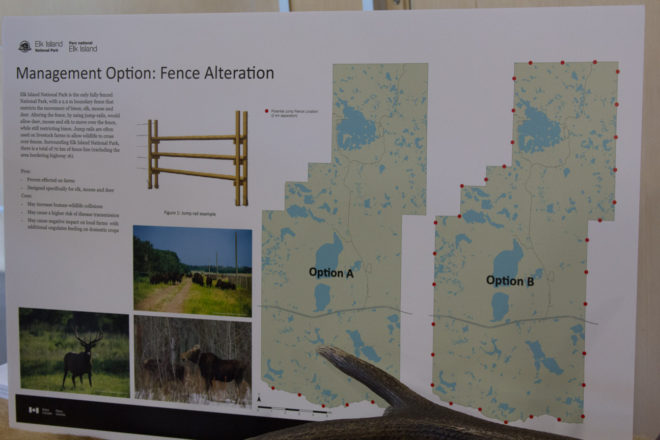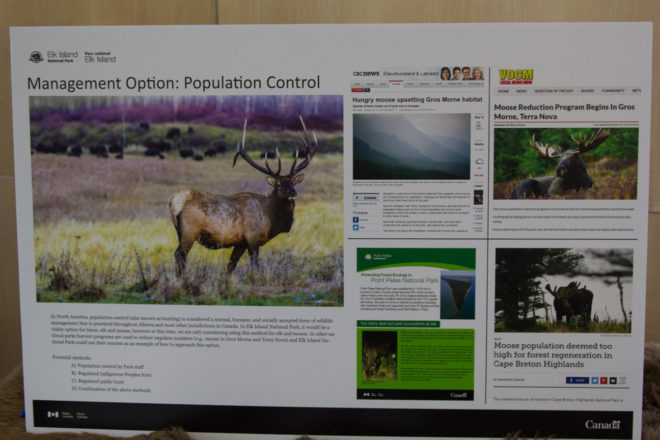
Animal compassion or cruelty?
That’s the choice Parks Canada is weighing. Tragically for the animals,
Parks Canada officials seem bent on choosing cruelty at Elk Island National Park.
June 3, 2017: FortSaskOnline – Elk Island National Park wildlife control: five options, including hunting
June 2, 2017: Global News – Full house as Elk Island National Park considers potential wildlife cull
June 2, 2017: CBC – Hunt, ship, slaughter or sell
The Issue
According to Parks Canada, there are too many elk in Elk Island National Park, about 200 too many. The park is about an hour’s drive east along the Yellowhead Highway out of Edmonton, Alberta. It’s a small park, only about 1/3 the area of the city of Edmonton itself.
Parks Canada claims it’s considering all options to reduce the elks’ numbers. But, its actions say something very different. We are convinced Parks Canada officials want to fix what they’re calling a “hyper-abundant” elk population problem by bringing in hunters to kill the elk. These same officials know there are non-lethal methods to control elk numbers, like translocation. How do they know this? They’ve used them in the past.
‘hyper-abundant’ is a propaganda word, promoted by individuals masquerading as scientists…and passed on to bureaucrats, managers and politicians…none of whom seem to know that the term has absolutely no basis in science. Regardless, the term has been used so often that it has become part of the mythology and is used almost universally to justify the culling of animals.
Dr. David Lavigne, unaffiliated zoologist
former professor, University of Guelph
former science advisor, International Fund for Animal Welfare
First, Elk Island National Park is not so much a park as an open-air zoo or game ranch. Unlike every other national park, Elk Island is entirely fenced. It is literally an “island” surrounded by agriculture. No elk, deer, or bison are allowed out of the park; no wolves, coyotes, bears, or cougars are allowed in. Just like a zoo. The park’s small size and fencing mean the park lacks the ecological robustness and integrity to naturally support the animal populations that Parks Canada exhibits for the benefit of visitors.
deer, or bison are allowed out of the park; no wolves, coyotes, bears, or cougars are allowed in. Just like a zoo. The park’s small size and fencing mean the park lacks the ecological robustness and integrity to naturally support the animal populations that Parks Canada exhibits for the benefit of visitors.
One of the major reasons that there are more elk in the park than the managers want is the lack of predators. What’s to be done, then, with the 200 elk the managers don’t want? This issue isn’t new. In the past, park officials translocated unwanted elk. However, those days are coming to an end. Parks Canada’s website explains why.
The costs and logistics in managing the elk population in the Park are becoming increasingly prohibitive … other options for managing the herd are presently being considered.
The “other options” is killing—the cheap and cruel choice. What’s particularly worrisome about lethal control is it doesn’t solve the issue. Put bluntly, Parks Canada is, effectively, considering opening Elk Island to an annual sport hunt of elk.
 There is a humane solution that fixes the issue of too many elk for the managers’ liking over the long-term: sterilizing male elk. This would involve live trapping the male elk (as is done now in the winter for translocation), administering a local anesthetic, doing the procedure, ear tagging the animal, and releasing him. This could be done as an annual routine, and it would keep the elk populations at a level acceptable to the managers.
There is a humane solution that fixes the issue of too many elk for the managers’ liking over the long-term: sterilizing male elk. This would involve live trapping the male elk (as is done now in the winter for translocation), administering a local anesthetic, doing the procedure, ear tagging the animal, and releasing him. This could be done as an annual routine, and it would keep the elk populations at a level acceptable to the managers.
But, it seems money is more important than compassion at Parks Canada. The point is, of course, that there are non-lethal methods to control the population of elk at Elk Island National Park. There’s no need to kill or hunt any elk.
How You Can Help
There are a number of ways to reach the Minister to voice your opposition to lethal management of the elk at Elk Island National Park. Hand-written letters and phone calls are best, but you may also download and print our sign-on letter by clicking here. Alternately, you may use the contact form below to send an email to the Minister.
Honourable Catherine McKenna, MP
Minister of Environment and Climate Change
House of Commons
Ottawa, ON K1A 0A6
T/ 613-996-5322
F/ 613-996-5323
Email: Catherine.McKenna@parl.gc.ca
About Elk¹
Description:
The North American elk, or wapiti, is the largest form of the red deer species Cervus elaphus. In general appearance elk are obviously kin to the well-known white-tailed deer. However, elk are much larger. Among Canadian deer, they are second in size only to the moose. An adult bull elk stands about 150 cm tall at the shoulder and weighs about 300 to 350 kg, although some large bulls approach 500 kg in late summer before the rut, or breeding season. Cows are substantially smaller but still have a shoulder height of 135 cm and an adult weight of around 250 kg.
The colour of the elk’s coat ranges from reddish brown in summer to dark brown in winter. Although it looks white from a distance, on closer inspection the rump colour is ivory to orange. In contrast to the rump, the head and neck are dark. Elk have long, blackish hair on the neck that is referred to as a mane.
Male elk are notable for their impressively large antlers. It is amazing that these large structures are grown new each year by the animals in a period of a few months in spring and summer. Antlers look particularly large in summer when they are encased in velvet—a covering that protects them during growth. In later summer, the velvet is rubbed from the fully grown antlers, revealing the bony structure. Newly cleaned antlers are light grey in colour but become stained by rubbing and thrashing through vegetation during the rutting season.
“Elk” is the name by which most Canadians know this majestic deer. “Wapiti,” meaning “white rump,” is the Shawnee Indian name and the common name preferred by scientists, because the animal known as an “elk” in Europe is not a red deer at all but a close relative of the North American moose. Other red deer, smaller and belonging to several subspecies, are found throughout the northern hemisphere: in Scotland and continental Europe, in North Africa, and in Asia.
The present population of elk in Canada is about 72 000. Over half of the animals (40 000) are in British Columbia, mostly in the Kootenays and in the Peace-Omineca Region, but with a small population on Vancouver Island. Alberta’s 20 000 elk roam mainly in the Rocky Mountain foothills and the mountain national parks of Banff, Jasper, and Waterton. A scattered population exists in the parkland across central Alberta, where the boreal, or northernmost, forest meets the grassland and the creation of Elk National Park has made a notable contribution to the survival of elk in Canada. The park grew from a reserve established in 1906 to protect a small band of remaining elk. The elk thrived, and currently the fenced park of less than 200 km2 supports over 1 000 elk as well as moose, bison, and white-tailed deer. Elk Island has provided many elk for reintroductions and has also served as a research area for study of the species.
Manitoba currently has a herd of around 7 000 animals, whose distribution centres on Riding Mountain National Park. The 15 000 elk in Saskatchewan are mostly in the southern fringe of the boreal forest north of Prince Albert and in the Moose Mountain, Cypress Hills, and Duck Mountain areas in the south of the province.
¹http://www.hww.ca/en/wildlife/mammals/north-american-elk.html
